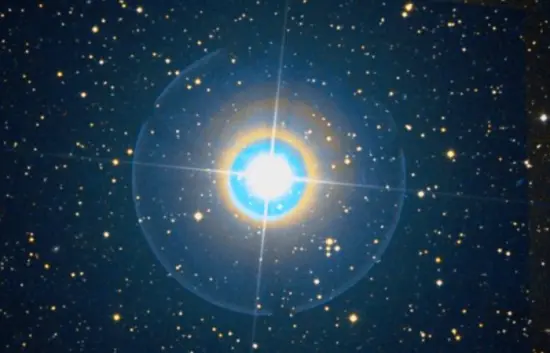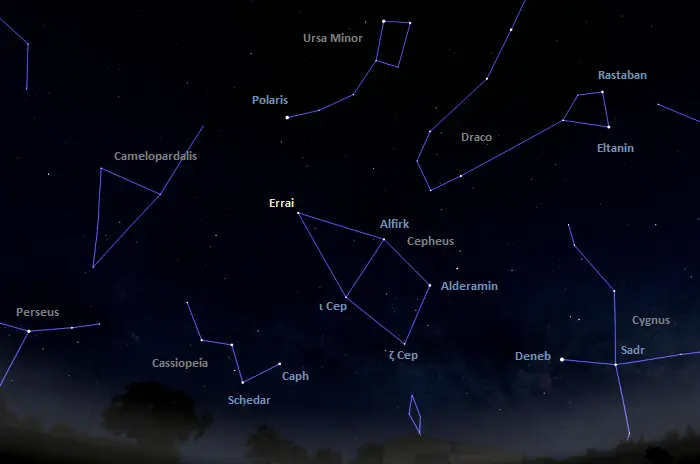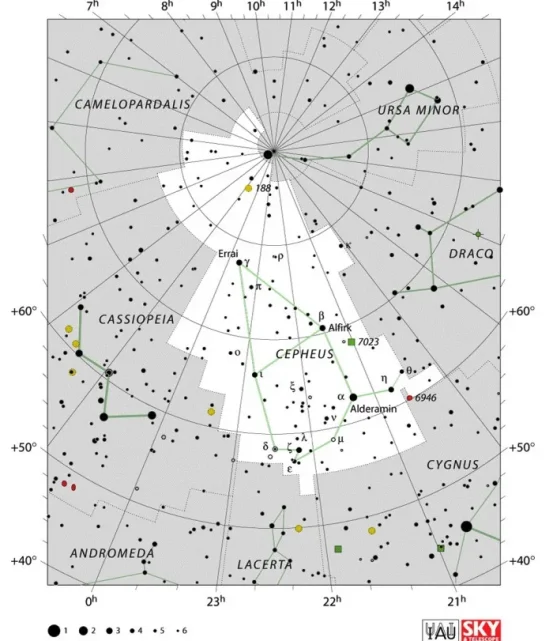Errai, Gamma Cephei (γ Cep), is the primary component in a binary star system located 44.98 light-years away in the northern constellation Cepheus. With an apparent magnitude of 3.21, it is the second brightest star in Cepheus, after Alderamin. Due to its location near the north celestial pole, the star never sets for most observers in the northern hemisphere.
Star system
Gamma Cephei is a spectroscopic binary system composed of the class K subgiant or giant star Gamma Cephei A and the red dwarf Gamma Cephei B. The two stars orbit each other with a period of 66.84 years. They are separated by 1.419 arcseconds, which corresponds to a physical distance of 19.56 astronomical units (Earth-Sun distances).
Gamma Cephei A, formally known as Errai, has the stellar classification K1III-IV CN1, indicating an orange giant or subgiant, a star that has come to the end of its main sequence lifetime. The CN1 suffix indicates the strength of the cyano radical (CN) bands.

Errai (Gamma Cephei), image: Wikisky
In 2018, an analysis of the spectrum of Errai yielded the closest match for a spectral type K1 III, indicating a giant star. The analysis was based on angular diameter measurements obtained with the Navy Precision Optical Interferometer, combined with the star’s distance and photometric data.
Errai has a mass of 1.294 solar masses and a radius 4.93 times that of the Sun. With a surface temperature of 4,792 K, it is 11.6 times more luminous than the Sun. The star is a slow spinner, with a projected rotational velocity of 1.63 km/s. It is younger than the Sun, with an estimated age of about 3.25 billion years.
The companion, Gamma Cephei B, is a red dwarf of the spectral type M4V. It has a mass 38.4% that of the Sun and is about 6.2 times fainter than the primary component. The companion’s mass was derived based on spectroscopic observations and imaging at the Calar Alto Observatory in Spain and on the data obtained with the Échelle spectrograph FLECHAS at the University Observatory Jena in Germany.
Gamma Cephei A and B are believed to be of similar age. Most of the system’s brightness comes from Errai.
Planet
An exoplanet was detected orbiting the primary component, Gamma Cephei A, in 2002. The planet was given the designation Gamma Cephei Ab and formally named Tadmor.
Gamma Cephei Ab has a mass of about 9.4 Jupiter masses and orbits the parent star with a period of 903.3 days. The mass was derived based on astrometric observations with the Fine Guidance Sensor on the Hubble Space Telescope (HST) in 2018.
The planet has an elliptical orbit with a semimajor axis of 2.05 ± 0.06 astronomical units. As it orbits, it comes within 1.81 astronomical units of Gamma Cephei A and moves as far away as 2.28 astronomical units. The distance is comparable to that from the Sun to the inner asteroid belt, beyond the orbit of Mars.
The planet’s orbit is roughly perpendicular to the orbit of Gamma Cephei A and B. Gamma Cephei B orbits the primary star at a separation that is only 9.8 times the semimajor axis of Tadmor. Like all planets in close binary star systems, Tadmor may be significantly affected by the dynamical perturbations in the system. These perturbations may have strongly influenced the planet’s formation and evolution.
In 2015, Gamma Cephei Ab was officially named Tadmor after a public nomination and vote, as part of the International Astronomical Union’s NameExoWorlds campaign. The name was submitted by the Syrian Astronomical Association. It comes from the modern Arabic name for the city of Palmyra, derived from the city’s ancient Semitic name. Palmyra is a UNESCO World Heritage Site. Its history dates to the Neolithic period. The oldest records of the name Tadmor date from the 18th century BCE.
Tadmor was arguably the first exoplanet ever discovered. Its existence was first suspected in July 1988, when a Canadian team of astronomers led by Bruce Campbell, Stephenson Yang, and Gordon Walker reported the discovery of a candidate exoplanet orbiting Errai. The team found a 2.7-year period, slightly longer than the currently accepted period of 903.3 days.
Anthony Lawton and P. Wright reported the detection of the extrasolar planet in the Journal of the British Interplanetary Society in 1989. The unconfirmed discovery was based on the same radial velocity method that was later used in the search for extrasolar planets. However, since the quality of the early data was not deemed good enough, the claims were challenged and subsequently retracted in 1992. If they had not been, this would have been the first real discovery of a planet outside the solar system.
The first confirmed discovery of an exoplanet came in 1992, when a system of three known planets was discovered orbiting the pulsar PSR B1257+12 in the constellation Virgo. The first planet discovered orbiting a main sequence star was Dimidium (51 Pegasi b), which orbits the Sun-like star 51 Pegasi, formally known as Helvetios, located in the constellation Pegasus.
The existence of Tadmor was not confirmed until September 24, 2002, when a team of astronomers at the Planetary Systems and Their Formation Workshop announced the discovery of a planet with a mass of at least 1.59 Jupiter masses orbiting Gamma Cephei A. Once Gamma Cephei B was directly detected in 2006, the parameters of the planet were recalculated.
Facts
Gamma Cephei was included on a list of suspected variable stars in 1884. It is still catalogued as a suspected variable. The star system’s brightness has been reported to vary between magnitudes 3.18 and 3.24.
Errai is sometimes listed as the third brightest star in Cepheus, not the second. The blue subgiant Alfirk (Beta Cephei) is the prototype for a class of pulsating variable stars known as the Beta Cephei variables. Its brightness varies from magnitude 3.16 to 3.27, while Errai’s fluctuates from magnitude 3.18 to 3.24.
The stars appear equally bright to the unaided eye, but they occasionally outshine each other and take turns as the second brightest star. Alfirk is much more intrinsically luminous than Errai. It shines with 15,100 solar luminosities from a distance of 690 light-years. Both stars are more than half a magnitude fainter than Alderamin (Alpha Cephei), which shines at magnitude 2.51.
Errai and Alderamin are separated by only 16 astronomical units. Other bright stars near Errai include Caph in Cassiopeia (19 light-years) and Eta Cephei (17 light-years).
North pole star
Errai will become the North Star, the nearest visible star to the north celestial pole, around the year 3,100 CE. It will take over from Polaris, the brightest star in the neighbouring constellation Ursa Minor. The change of pole stars is a consequence of the precession of the equinoxes (axial precession), a slow and gradual change in the orientation of the Earth’s rotational axis.
Errai will not be as accurate a marker of true north as Polaris is today. Polaris comes within 0.5 degrees of the pole, while Errai will come within 3 degrees at its closest approach around the year 4,000 CE. Errai is also fainter than Polaris and will not be as easy to pinpoint in less-than-ideal conditions.
Errai will be succeeded by its fainter Cepheus neighbours Iota and Beta Cephei (Alfirk) around the year 5,900 CE. The two stars will share time as the North Stars until the brighter Alderamin takes over in 7,600 CE. Iota and Beta Cephei will only come within 5 degrees of the pole, while Alderamin will come within 3 degrees, like Errai. After Alderamin, the north pole will gradually drift toward Deneb in the constellation Cygnus.
Name
The name Errai (pronunciation: /ɛˈreɪ.iː/) comes from the Arabic ar-rā‘ī, meaning “shepherd.” It was approved by the International Astronomical Union’s (IAU) Working Group on Star Names (WGSN) on December 15, 2015. It formally applies only to the component Gamma Cephei A but has traditionally been used for the entire system. The name was historically also spelled Alrai, Al Rai, and Arrai.
The star Beta Ophiuchi was also traditionally known as Alrai, but now has the formal name Cebalrai, from the Arabic kalb al-rā‘ī, meaning “the shepherd’s dog.”
In Chinese astronomy, Gamma Cephei was known as 少衛增八 (Shàowèi Zēng Bā), meaning “the eighth added star of Shaowei (Left Wall Second Imperial Guard)”. The star was part of the Left Wall of the Purple Forbidden Enclosure, an asterism that represented the imperial palace. The asterism was formed by Errai with Edasich (Iota Draconis), Theta Draconis, Athebyne (Eta Draconis), Aldhibah (Zeta Draconis), Upsilon Draconis, 73 Draconis, and 23 Cassiopeiae.
Location
Errai is easy to find because it is part of the distinctive constellation figure of Cepheus (the King). It marks the top of the house asterism that makes Cepheus easily recognizable. Alderamin, the constellation’s brightest star, appears at the base of the stick house. It can be found by extending a line from Schedar, the bottom right star of Cassiopeia’s W, through Caph, the rightmost star of the W.

The location of Errai (Gamma Cephei), image: Stellarium
Errai lies in the far northern sky, near the northern celestial pole, and stays invisible for most observers in the southern hemisphere. For those in equatorial latitudes, it appears very low above the horizon.
For northern observers, Errai appears in the northern sky, southeast of Polaris. It is the brightest star in the area between Polaris and Caph in Cassiopeia.
Constellation
Errai is located in the constellation Cepheus. Cepheus (the King) is one of the 48 ancient constellations catalogued by Claudius Ptolemy in his Almagest in the 2nd century CE. In Greek mythology, it represents the King Cepheus of Aethiopia, the husband of Cassiopeia and father of Andromeda.
Cepheus lies in the far northern sky and is largely invisible to observers in the southern hemisphere. Several of its stars – Alderamin, Errai, Iota Cephei, and Alfirk – take their turn as the North Star over the course of the Earth’s 26,000-year axial precession cycle. Alfirk (Beta Cephei) is a prototype for the Beta Cephei variables, a class of pulsating variable stars.

Cepheus constellation map by IAU and Sky&Telescope magazine
Other notable stars in Cepheus include Delta Cephei, another variable class prototype, the multiple star system Xi Cephei (Kurhah), and the red supergiants VV Cephei A and Mu Cephei (Herschel’s Garnet Star), both among the largest stars known.
Interesting deep sky objects in the constellation include the open cluster NGC 188, one of the oldest objects of its kind discovered to date, the Fireworks Galaxy (NGC 6946), a spiral galaxy that hosted 10 supernovae in the past century, the reflection nebulae Sh2-136 (the Ghost Nebula), NGC 7129 (the Rosebud Nebula), and NGC 7023 (the Iris Nebula), the planetary nebula NGC 40 (the Bow-Tie Nebula), and the star-forming nebulae Sh2-155 (the Cave Nebula) and NGC 7380 (the Wizard Nebula).
The best time of the year to observe the stars and deep sky objects in Cepheus is during the month of November, when the constellation is prominent in the evening sky. The entire constellation is visible from locations north of the latitude 10° S.
The 10 brightest stars in Cepheus are Alderamin (Alpha Cep, mag. 2.5141), Errai (Gamma Cep, mag. 3.21), Alfirk (Beta Cep, mag. 3.23), Zeta Cephei (mag. 3.35), Eta Cephei (mag. 3.426), Iota Cephei (mag. 3.507), Delta Cephei A (mag. 4.07), Epsilon Cephei (mag. 4.18), Theta Cephei (mag. 4.22), and Mu Cephei (4.23).
Errai – Gamma Cephei
| Spectral class | K1III-IV CN1 + M4V |
| Variable type | Suspected (γ Cep A) |
| U-B colour index (γ Cep A) | +0.94 |
| B-V colour index (γ Cep A) | +1.03 |
| Apparent magnitude | 3.21 |
| Absolute magnitude | 2.62 |
| Distance | 44.98 ± 0.09 light-years (13.79 ± 0.03 parsecs) |
| Parallax | 72.5167 ± 0.1470 mas |
| Radial velocity | -43.668 ± 0.0002 km/s |
| Proper motion | RA: – -64.860 ± 0.143 mas/yr |
| Dec.: 171.159 ± 0.141 mas/yr | |
| Mass (γ Cep A, γ Cep B) | 1.294 ± 0.081 M☉, 0.384 ± 0.013 M☉ |
| Luminosity (γ Cep A) | 11.6 ± 0.6 L☉ |
| Radius (γ Cep A) | 4.93 ± 0.04 R☉ |
| Temperature (γ Cep A) | 4,792 ± 62 K |
| Metallicity (γ Cep A) | -0.05 dex |
| Age (γ Cep A) | 3.25 ± 0.63 billion years |
| Rotational velocity (γ Cep A) | 1.63 km/s |
| Surface gravity (γ Cep A) | +3.18 cgs |
| Constellation | Cepheus |
| Right ascension | 23h 39m 20.9104133784s |
| Declination | +77° 37′ 56.510781384″ |
| Names and designations | Errai, Gamma Cephei, γ Cep, 35 Cephei, HD 222404, HR 8974, HIP 116727, SAO 10818, Gl 903, FK5 893, BD +76°928, GCTP 5725.00, AG+77 685, GC 32875, GSC 04606-03584, JP11 3644, IRAS 23372+7721, 2MASS J23392083+7737563, NSV 14656, PPM 11709, UBV 20359, TYC 4606-3584-1, USNO-B1.0 1676-00142230, Gaia DR2 2281778105591104768, Gaia DR3 2281778105594488192, WDS J23393+7738AB |